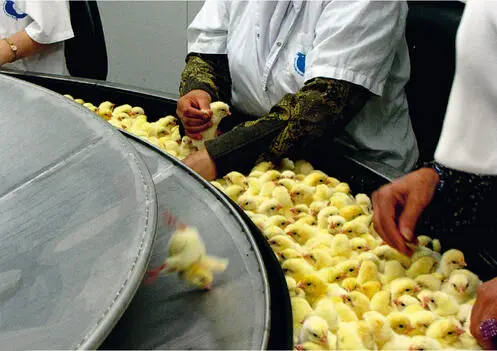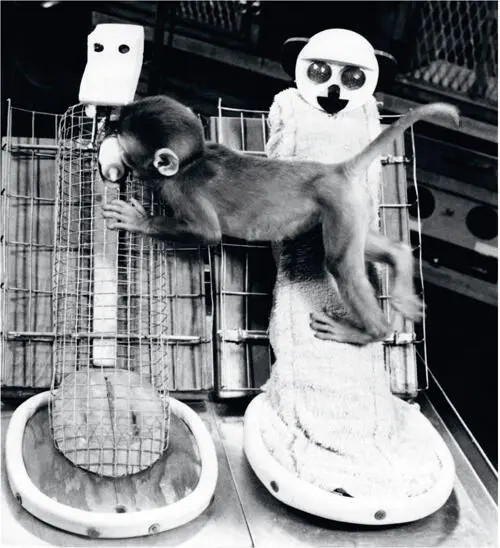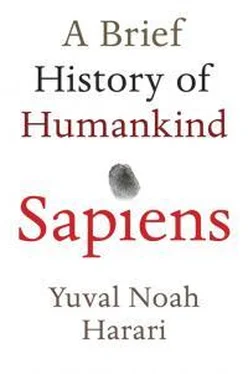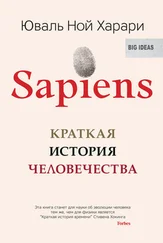Life on the Conveyor Belt
The Industrial Revolution yielded an unprecedented combination of cheap and abundant energy and cheap and abundant raw materials. The result was an explosion in human productivity. The explosion was felt first and foremost in agriculture. Usually, when we think of the Industrial Revolution, we think of an urban landscape of smoking chimneys, or the plight of exploited coal miners sweating in the bowels of the earth. Yet the Industrial Revolution was above all else the Second Agricultural Revolution.
During the last 200 years, industrial production methods became the mainstay of agriculture. Machines such as tractors began to undertake tasks that were previously performed by muscle power, or not performed at all. Fields and animals became vastly more productive thanks to artificial fertilisers, industrial insecticides and an entire arsenal of hormones and medications. Refrigerators, ships and aeroplanes have made it possible to store produce for months, and transport it quickly and cheaply to the other side of the world. Europeans began to dine on fresh Argentinian beef and Japanese sushi.
Even plants and animals were mechanised. Around the time that Homo sapiens was elevated to divine status by humanist religions, farm animals stopped being viewed as living creatures that could feel pain and distress, and instead came to be treated as machines. Today these animals are often mass-produced in factory-like facilities, their bodies shaped in accordance with industrial needs. They pass their entire lives as cogs in a giant production line, and the length and quality of their existence is determined by the profits and losses of business corporations. Even when the industry takes care to keep them alive, reasonably healthy and well fed, it has no intrinsic interest in the animals’ social and psychological needs (except when these have a direct impact on production).
Egg-laying hens, for example, have a complex world of behavioural needs and drives. They feel strong urges to scout their environment, forage and peck around, determine social hierarchies, build nests and groom themselves. But the egg industry often locks the hens inside tiny coops, and it is not uncommon for it to squeeze four hens to a cage, each given a floor space of about twenty-five by twenty-two centimetres. The hens receive sufficient food, but they are unable to claim a territory, build a nest or engage in other natural activities. Indeed, the cage is so small that hens are often unable even to flap their wings or stand fully erect.
Pigs are among the most intelligent and inquisitive of mammals, second perhaps only to the great apes. Yet industrialised pig farms routinely confine nursing sows inside such small crates that they are literally unable to turn around (not to mention walk or forage). The sows are kept in these crates day and night for four weeks after giving birth. Their offspring are then taken away to be fattened up and the sows are impregnated with the next litter of piglets.
Many dairy cows live almost all their allotted years inside a small enclosure; standing, sitting and sleeping in their own urine and excrement. They receive their measure of food, hormones and medications from one set of machines, and get milked every few hours by another set of machines. The cow in the middle is treated as little more than a mouth that takes in raw materials and an udder that produces a commodity. Treating living creatures possessing complex emotional worlds as if they were machines is likely to cause them not only physical discomfort, but also much social stress and psychological frustration. 7

40. Chicks on a conveyor belt in a commercial hatchery. Male chicks and imperfect female chicks are picked off the conveyor belt and are then asphyxiated in gas chambers, dropped into automatic shredders, or simply thrown into the rubbish, where they are crushed to death. Hundreds of millions of chicks die each year in such hatcheries.
Just as the Atlantic slave trade did not stem from hatred towards Africans, so the modern animal industry is not motivated by animosity. Again, it is fuelled by indifference. Most people who produce and consume eggs, milk and meat rarely stop to think about the fate of the chickens, cows or pigs whose flesh and emissions they are eating. Those who do think often argue that such animals are really little different from machines, devoid of sensations and emotions, incapable of suffering. Ironically, the same scientific disciplines which shape our milk machines and egg machines have lately demonstrated beyond reasonable doubt that mammals and birds have a complex sensory and emotional make-up. They not only feel physical pain, but can also suffer from emotional distress.
Evolutionary psychology maintains that the emotional and social needs of farm animals evolved in the wild, when they were essential for survival and reproduction. For example, a wild cow had to know how to form close relations with other cows and bulls, or else she could not survive and reproduce. In order to learn the necessary skills, evolution implanted in calves – as in the young of all other social mammals – a strong desire to play (playing is the mammalian way of learning social behaviour). And it implanted in them an even stronger desire to bond with their mothers, whose milk and care were essential for survival.
What happens if farmers now take a young calf, separate her from her mother, put her in a closed cage, give her food, water and inoculations against diseases, and then, when she is old enough, inseminate her with bull sperm? From an objective perspective, this calf no longer needs either maternal bonding or playmates in order to survive and reproduce. But from a subjective perspective, the calf still feels a very strong urge to bond with her mother and to play with other calves. If these urges are not fulfilled, the calf suffers greatly. This is the basic lesson of evolutionary psychology: a need shaped in the wild continues to be felt subjectively even if it is no longer really necessary for survival and reproduction. The tragedy of industrial agriculture is that it takes great care of the objective needs of animals, while neglecting their subjective needs.
The truth of this theory has been known at least since the 1950s, when the American psychologist Harry Harlow studied the development of monkeys. Harlow separated infant monkeys from their mothers several hours after birth. The monkeys were isolated inside cages, and then raised by dummy mothers. In each cage, Harlow placed two dummy mothers. One was made of metal wires, and was fitted with a milk bottle from which the infant monkey could suck. The other was made of wood covered with cloth, which made it resemble a real monkey mother, but it provided the infant monkey with no material sustenance whatsoever. It was assumed that the infants would cling to the nourishing metal mother rather than to the barren cloth one.
To Harlow’s surprise, the infant monkeys showed a marked preference for the cloth mother, spending most of their time with her. When the two mothers were placed in close proximity, the infants held on to the cloth mother even while they reached over to suck milk from the metal mother. Harlow suspected that perhaps the infants did so because they were cold. So he fitted an electric bulb inside the wire mother, which now radiated heat. Most of the monkeys, except for the very young ones, continued to prefer the cloth mother.

41. One of Harlow’s orphaned monkeys clings to the cloth mother even while sucking milk from the metal mother.
Читать дальше





![Юваль Ной Харари - Sapiens. Краткая история человечества [litres]](/books/34310/yuval-noj-harari-sapiens-kratkaya-istoriya-cheloveche-thumb.webp)





![Юваль Ной Харари - 21 урок для XXI века [Версия с комментированными отличиями перевода]](/books/412481/yuval-noj-harari-21-urok-dlya-xxi-veka-versiya-s-ko-thumb.webp)


